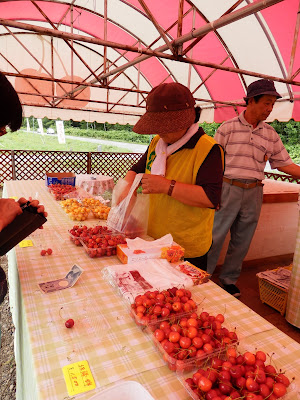If you are not particularly interested in Japanese traditional culture, almost all the shrines and temples may look the same, or similar, to you. Most of my students cannot even tell which one is temple and which is shrine.
I'm not blaming you at all. It is natural. I still remember an American guy said to me, "When I saw a gorgeous temple or shrine for the first time, I thought wow, it's great. But after visiting two or three, I was getting tired. They are the same anyway. Now I think you should not visit more than two temples or shrines on the same day."
Well, I agree. One per day is probably enough, but there are so many interesting shrines and temples worth visiting. Even today these religious places are considered as power spots. If you are a spiritual person, you may feel something.
Unfortunately I'm not very religious person and don't care about spiritualism either. Even so, I feel like visiting such places occasionally to wish happiness and health for someone, or for no special reason.
The other day, I visited the Nezu Shrine in Tokyo, well-known for the big festival that takes place in September. It is also famous for its azalea garden and many people come and see the flowers in April and May, but usually the shrine is very calm and quiet despite its historical value.
This is the torii gate of Nezu Shrine. Torii is built at the entrancence of the shinto shrine to mark a sacred precinct. If you see a structure like this, the place is not a Buddhist temple but a shinto shrine.
Shinto is Japanese indigenous religion that worships holy spirits or deities called "kami." In Shinto they say there are 8 millions of kami in this world, implying there are too many to count. It resembles Greek myth a little, but not all the shinto dieties take human forms. In many cases they are the spirits of ancestors, or even just concepts important to people such as fertility and prosperity, therefore invisible.
The main shrine building of Nezu Shrine was built at the present location in 1706 by order of the fifth Tokugawa shogun Tsunayoshi.

This is the image of Suranoo no Mikoto. Looks a little like a hippie though...
Actually, while vast urban area in Tokyo was burnt down by the Great Tokyo Air Raids in 1945, this shrine miraculously survived, and it has been designated as the nation's important cultural property. Some people say the shrine was able to keep off bad luck by the protection of the deity.
If you want to be protected from evil and disasters, why don't you buy a charm at the shrine?
This "Romon" or two-story gate with a roof is also the country's important cultural asset.
In the precinct, there is another smaller shrine called Otome Inari, where Uka no Mitama no Mikoto (what a long name!), a god of crops and commerce, is enshrined. At Inari shrines, a pair of fox figures are placed, instead of komainu (guardian dogs).
As many merchants who worship this god of commerce have offered torii gates, some Inari shrines have a vermillion tunnel called Senbon Torii (thousands of torii gate) like this. Very mysterious looking...
1-28-9 Nezu, Bunkyo-ku, Tokyo
tel: 03-3822-0753
5min. from Nezu or Sendagi station on the subway Chiyoda Line, or Todai-mae station on the subway Nanboku line.
ここからは、日本語で。
From here I'll write in Japanese.
みなさん、こんにちは。
もし日本の伝統的な文化にあまり興味がなければ、寺と神社の違いもわからないですよね。
伝統的 でんとうてき traditional
文化 ぶんか culture
興味(きょうみ)がある be interested in
寺 てら Buddhist temples
神社 じんじゃ shinto shrine
違い ちがい difference
日本には見るべき寺や神社がたくさんありますので、これから時々紹介していきます。
見るべき (みる~) should see
時々 ときどき occasionally
紹介(しょうかい)する to introduce
今日は東京にある根津神社をご紹介。9月に行われる祭りと、4~5月に満開になるつつじの庭で有名ですが、普段はとても静かです。
根津神社 ねづじんじゃ Nezu Shrine
行われる おこなわれる to take place
満開 まんかい to be in full bloom
つつじ azalea
庭 にわ garden
有名 ゆうめい famous
普段 ふだん usually
静か しずか quiet
根津神社が今の場所に建てられたのは1706年、将軍徳川綱吉の命令によるものでした。
場所 ばしょ location
建てられる たてられる to be constructed
年 ~ねん year
将軍 しょうぐん shogun
徳川綱吉 とくがわ つなよし name of the fifth shogun of the Tokugawa Shogunate.
奉られている神さまは嵐の神、スサノオノミコトです。神話によると、スサノオは頭が8つある蛇を退治した英雄です。その強い力で災難からお参りした人を守ってくれるそうです。
奉(まつ)られている enshrined
神(かみ)さま deity
嵐 あらし storm
蛇 へビ serpent
英雄 えいゆう hero
災難 さいなん disasters
お参(まい)りする to visit shrines
守(まも)る to protect
根津神社内には、乙女稲荷という別の神社があります。赤い鳥居がトンネルのように並んでいて、面白いです。
乙女稲荷 おとめいなり the name of the shrine
赤い あかい red
鳥居 とりい
面白い おもしろい interesting









 I
I






































